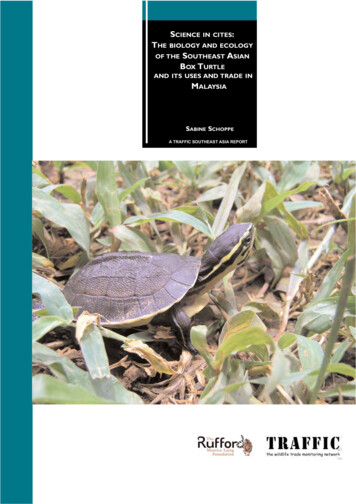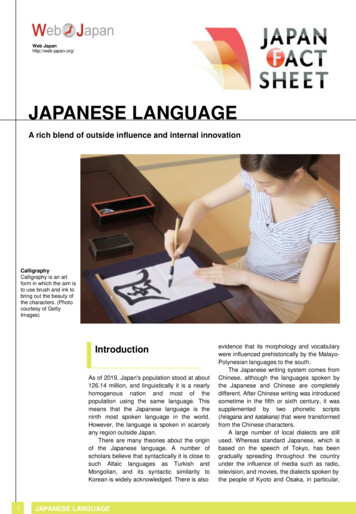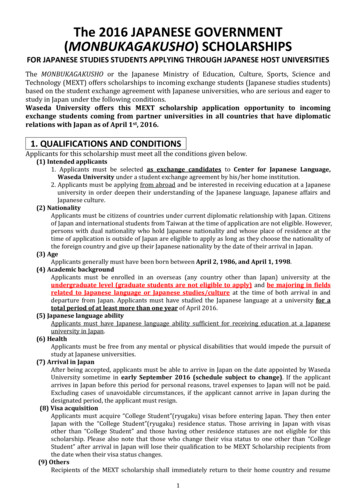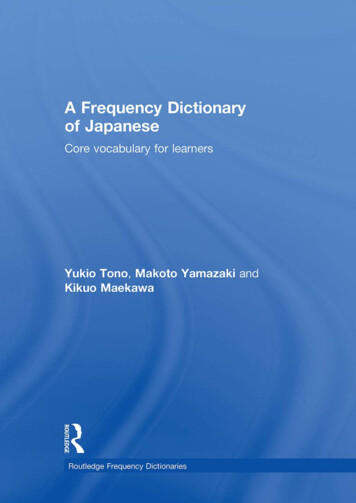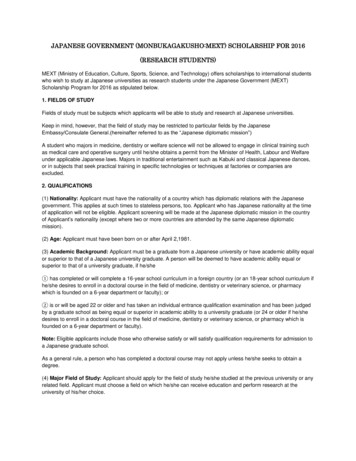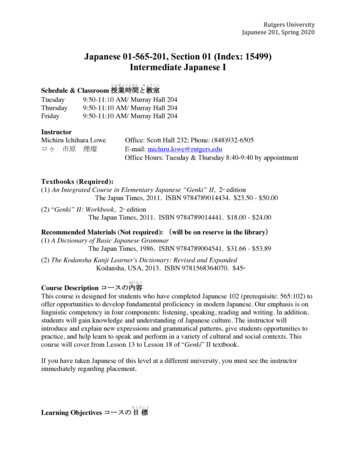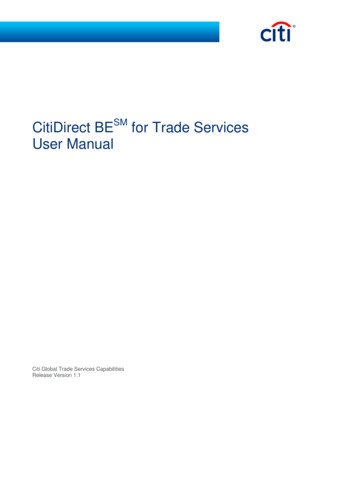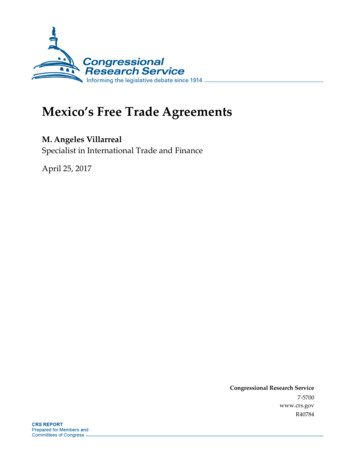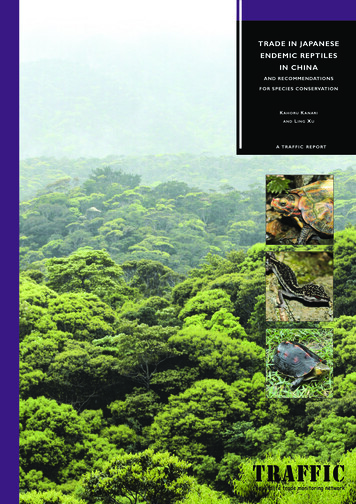
Transcription
TRADE IN JAPANESEENDEMIC REPTILESIN CHINAAND RECOMMENDATIONSFOR SPECIES CONSERVATIONK AHORU K ANARIANDL ING X UA TRAFFIC REPORT
Published by TRAFFIC. 2012 TRAFFIC International.All rights reserved.All material appearing in this publication iscopyrighted and may be reproduced withperrmission. Any reproduction in full or inpart of this publication must credit TRAFFICas the copyright owner.The views of the authors expressed in thispublication do not necessarily reflect those ofTRAFFIC, WWF or IUCN.The designations of geographical entities inthis publication, and the presentation of thematerial, do not imply the expression of anyopinion whatsoever on the part of TRAFFICor its supporting organizations concerning thelegal status of any country, territory, or area,or of its authorities, or concerning the delimitation of its frontiers or boundaries.The TRAFFIC symbol copyright andRegistered Trademark ownership is held byWWF. TRAFFIC is a strategic alliance ofWWF and IUCN.Suggested citation: Kanari, K. and Xu, L.(2012). Trade in Japanese Endemic Reptiles inChina and Recommendations for SpeciesConservation. TRAFFIC.ISBN 978-1-85850-356-1Front cover photograph: Yambaru Forest,Okinawa Jiwa, Okinawa, Japan (backgroundphoto); Ryukyu Black-breasted Leaf TurtleGeoemyda japonica; Kuroiwa's Ground GeckoGoniurosaurus kuroiwae kuroiwae; RyukyuYellow-margined Box Turtle Cuora flavomarginata evelynae (inset, from top to bottom). .Photograph credits: Taku Sakoda(background photo); Taku Sakoda (inset, toptwo photos); Tomoko Suzuki/WWF Japan(inset, bottom photo).
TRADE IN JAPANESE ENDEMICREPTILES IN CHINAAND RECOMMENDATIONS FOR SPECIESCONSERVATIONCredit: Taku Sakodaby Kahoru Kanari and Ling XuKuroiwa’s Ground Gecko Goniurosauruskuroiwae kuroiwae, a Japanese endemic reptileseen in pet shops in Hong Kong
CONTENTSAcknowledgementsiiExecutive ecommendations16References18Annex21iiTRADE IN JAPANESE ENDEMIC REPTILES IN CHINA
ACKNOWLEDGEMENTSThe authors are grateful to Professor Hidetoshi Ota (University of Hyogo) for valuable advice on thedraft. Thanks also go to TRAFFIC colleagues Dr Ayako Toko, Thomasina Oldfield, Dr ChrisShepherd, James Compton, Julie Gray, Richard Thomas and Steven Broad for patient assistance andgreat support.TRAFFIC is thankful to the people of Okinawa, Japan, who supported information-collection, fortheir open hearted support and the provision of precious local knowledge.TRAFFIC thanks WWF Japan for its financial support for this report and the study on which it isbased.The Rufford Foundation is gratefully acknowledged for its support to TRAFFIC in publicationprocesses.TRADE IN JAPANESE ENDEMIC REPTILES IN CHINAiii
EXECUTIVE SUMMARYEighty-seven species of reptile are currently recorded as living in the wild in Japan. Some of thesespecies are designated as protected species under Japan’s national legislation for ecological or culturalreasons. While some of these species are traded internationally, clarifications are still neededregarding trade dynamics as well as the legal system regulating this trade. This report presents anoverview of the Japanese domestic legal system with regard to Japanese reptiles and the trade inJapanese endemic reptiles in Hong Kong and key cities in mainland China, as these locations havebeen identified as key trade hubs for wildlife products and are geographically close to Japan andillustrative of the international trade from Japan.Several Japanese laws give protection for wildlife in Japan. One of them is the Law for the Protectionof Cultural Properties which states that activities that “change the existing state” of national “NaturalMonuments” are prohibited. This law designates some Japanese endemic species as “NaturalMonuments” in the interests of protecting culturally significant plant and animal species.Despite such legal protection, this study highlights issues of illegal trade in specimens of Japaneseendemic reptile species found for sale in pet shops and markets in Hong Kong and mainland China, aswell as Chinese-language online trade websites. Through a survey of markets and shops, four of fivefocal species—Ryukyu Black-breasted Leaf Turtle Geoemyda jaopnica, Ryukyu Yellow-marginedBox Turtle Cuora flavomarginata evelynae, Kishinoue’s Giant Skink Plestiodon kishinouyei andKiroiwa’s Ground Gecko Goniurosaurus kuroiwae—were found mainly in Hong Kong, as well aspotentially in Guangzhou. The two freshwater turtle taxa and Kuroiwa’s Ground Gecko were alsofound for sale on Chinese-language websites. Some of the animals on sale were found to beaccompanied by declarations stating that they were wild-caught, and this was therefore in directviolation of Japanese domestic regulations.Reptiles comprise a group for which various problems related to illegal trade have been noted in thepast in Japan. In the case of freshwater turtles in particular, there is an urgent need for increasedconservation measures to be taken, especially with regard to Japan’s endemic species.Based on the findings of this study, TRAFFIC makes the following recommendations:To the Japanese CITES Scientific Authority:Consider the merits of submission of CITES listing proposals for Ryukyu Black-breastedLeaf Turtle, Ryukyu Yellow-margined Box Turtle, Kishinoue’s Giant Skink and Kiroiwa’sGround Gecko and, in connection with this: ivconduct further research concerning population status and levels of trade, to inform evaluationof the likely effectiveness of CITES listing, and selection of appropriate Appendix for eachspecies; andurgently consider submission of listing proposals at the 16th meeting of the Conference of theParties to CITES, with a view to preventing further detrimental exploitation throughinternational trade.TRADE IN JAPANESE ENDEMIC REPTILES IN CHINA
Conduct and support further long-term monitoring to understand the relevant trade dynamicsbetter, including market surveys in peak seasons of trade. Further investigation would beuseful in markets such as Taiwan that are linked to Japan by frequent direct means oftransport, as well as in other locations with an active reptile trade, to understand routes usedand combat any illegal trade.Provide information to the destination Parties, specifically China, regarding Japan’s domesticregulations to protect species, so that China and other market destinations can be aware oftrade in imported wild specimens from Japan, that are fully protected by law in that country.In addition, inform the CITES Secretariat of a zero quota for the CITES Appendix-II listedRyukyu Yellow-margined Box Turtle from Japan, so that all Parties to CITES recognizeJapan’s national regulation.Raise awareness of the biological status of Japanese endemic species, and regulationsgoverning those species, including through engagement of relevant stakeholders and thegeneral public, in areas around the species’ habitat, trade routes and destinations.To Japanese lawmakers:In order to preserve Japan’s endemic reptile species, Japan should improve speciesconservation regulations to strengthen protection and conservation of the taxa themselves andwider biodiversity. Establishment of measures for conservation are recommended, includingwithin the framework of the Law for the Conservation of Endangered Species of Wild Faunaand Flora. This would further strengthen existing protection measures for culturallyimportant wild species.To prevent further damage to Japan’s endemic threatened species populations, specialmeasures for further restriction of international trade in Yellow-margined Box Turtle Cuoraflavomarginata, such as imposing an import ban for foreign specimens of Common Yellowmargined Box Turtle C. f. flavomarginata, should be considered and made effective.To law enforcement agencies and their administrative authorities:Strengthen the effectiveness of Japan’s domestic law enforcement. Even though existinglegislation is strong, effective implementation and enforcement against illegal activities iscrucial in order for the law to be effective. The fact that trade of endemic species supposedlyprotected in Japan occurs in foreign markets indicates illegal collection and illegal export.Strengthening of law enforcement at Japan’s borders as well as in wild habitat is urgent.Regular monitoring of pet shops and markets or trade routes should be pursued to discernactive and potential trade locations and sources of illegal animals for domestic andinternational trade.TRADE IN JAPANESE ENDEMIC REPTILES IN CHINAv
Organize capacity-building and training for law enforcement officers to increase awareness ofregulations and to improve identification of species/subspecies.To the authorities of destination markets—mainland China and Hong KongGreater understanding is needed regarding the legislation of source countries for importedspecies in trade. Once the specimens in question have been taken abroad they are beyond thereach of the source country’s domestic legislation, therefore it is essential to obtain cooperation from authorities regulating the destination markets. Pet shops and physicalmarkets, as well as online trade, should be monitored to ensure they do not to become hotbedsof illegal trade. In addition, any captive-bred claims should be closely checked and verifiedso that false documentation does not facilitate illegal trade in wild-captured specimens.viTRADE IN JAPANESE ENDEMIC REPTILES IN CHINA
BACKGROUNDJapan has a rich array of native reptile species, with a total of 871 species, including some introduced,many of which are found nowhere else (Herpetological Society of Japan, 2012). On the islands ofNansei Shotō in the south-east (Figure 1) in particular, there are a number of species of reptile uniqueto the region, with some found on only one or a few islands. Some of these are designated asprotected species under Japanese domestic law for ecological and/or cultural reasons, yet uncontrolledand illegal harvest and trade remains a threat to these unique examples of Japan’s natural heritage.Figure 1.Map showing the location of Nansei ShotōIn some cases, harvest and trade takes place in contravention of Japan’s regulations. For example, inJune 1993, reptiles including the endemic Kuroiwa’s Ground Gecko Goniurosaurus kuroiwae werecaptured by an American national without permission and later discovered in a hotel room at anAmerican military base in Japan (Ota, 2000). In North America, the endemic Ryukyu Black-breastedLeaf Turtle Geoemyda japonica is traded in the pet market, commanding high prices due to its rarity(Lee, 2004). A Ryukyu Black-breasted Leaf Turtle was observed for sale on a French reptile trader’swebsite in February 2011 (Anon., 2011). A specialist confirmed that three Ryokyu Black-breastedLeaf Turtles and a presumed Ryukyu Yellow-margined Box Turtle Cuora flavomarginata evelynaewere on sale at a market in Hong Kong in March, 2011 (van Dijk, P.P. in litt., 26 May 2011).In addition to the above examples, TRAFFIC has received information from the USA that from 2004to November 2011 the US border authority, the US Fish and Wildlife Service, cleared at least 301 Including Cheloniidae spp., Hydrophiinae spp. and species introduced into Japan and now established in the wild. Excluding specieswithout scientific names.TRADE IN JAPANESE ENDEMIC REPTILES IN CHINA1
Ryukyu Black-breasted Leaf Turtles into the USA (US Fish and Wildlife Service, 2011). The numberof individuals could be higher than reported, if imports were recorded as “non CITES reptiles”.While there have been examples and indications that illegal international trade in Japanese protectedreptiles has been taking place, until now details of the actual situation have been insufficient andfurther research and investigation have been required. In recent years, the remarkable economicgrowth of China has had significant impacts on global wildlife trade (Shepherd, 2000; The WorldBank 2005; Gratwicke et al. 2008; Godoy et al. 2009). China has long been a major consumer ofwildlife and the levels of consumption, the volumes of wildlife and the number of species involved, isincreasing (Rabinowitz and Khaing, 1998; Lau et al. 2010). Additionally, China is increasinglyplaying a role as a transit point in the global wildlife trade chain, and a source of captive-bred wildlifeand wildlife products (The World Bank 2005; Felbab-Brown, 2011). Efforts to produce nativewildlife species through commercial captive-breeding operations in China are also increasing (Lamand Xu, 2008). Needless to say, China’s increasing significance in the global wildlife trade arena hashad significant effects on the wildlife trade dynamics in neighbouring Japan. In these rapidlychanging times, there is an urgent need to investigate and to understand the actual situation withrespect to how and where Japanese endemic species are being traded, in order to respond accordingly.Credit: Taku SakodaThis report provides an overview of the present situation of wildlife trade control under the existing legalsystem in Japan with a focus on Japanese endemic reptiles. At the same time, an attempt is made toillustrate the current levels of international trade, using China’s market as a case study example.METHODSYambaru forest, Okinawa Jima (see Figure 1)2TRADE IN JAPANESE ENDEMIC REPTILES IN CHINA
Five sites were selected for surveying, including Hong Kong and four cities in mainland China—Beijing, Tianjin, Shanghai and Guangzhou (see Figure 2). These sites were selected for studybecause they have been identified as key trade hubs for wildlife products, geographically close toJapan and illustrative of the international trade from Japan. Also, Hong Kong has been identified as alocation with pet shops and markets selling Japanese endemic reptile species.Focal speciesFive reptile species or subspecies endemic to Japan were the focus of this study:1. Ryukyu Black-breasted Leaf Turtle Geoemyda japonica2. Ryukyu Yellow-margined Box Turtle Cuora flavomarginata evelynae3. Kishinoue’s Giant Skink Plestiodon kishinouyei4. Kuroiwa’s Ground Gecko Goniurosaurus kuroiwae ssp.5. Miyako Grass Lizard Takydromus toyamaiCredit: Taku SakodaAlthough the common name Kuroiwa’s Ground Gecko technically only refers to one of fivesubspecies, in this report the name is used to refer at species level, apart from where sub-specificcommon names are given, for example in Box 1.Kuroiwa’s Ground Gecko Goniurosaurus kuroiwae kuroiwaeTRADE IN JAPANESE ENDEMIC REPTILES IN CHINA3
These reptile taxa were selected because they are endemic to Japan and threatened in the wild. Thespecies are all classified as threatened species in Japan’s Red List and in the IUCN Red List, theMiyako Grass Lizard being categorized as Critically Endangered in the former. Capture of the otherfour species has been prohibited, but research on international trade in these species has been limiteduntil now. Box 1 contains descriptive details for each species.National legislationA review of Japan’s current legislation with respect to the protection and trade in native reptiles wascarried out. Further information with regards to implementation and enforcement of these relevantpieces of legislation was gathered through a study of existing published literature and through formaland informal interviews carried out with relevant departments and individuals.Trade data collectionInformation on the trade in reptiles, focusing on the selected key species, was collected for analysisfrom published and unpublished literature, through formal and informal interviews with experts andother relevant parties. Based on these findings, market surveys were carried out in Hong Kong andmainland China (see Figure 2). Online Chinese-language trade markets were also surveyed.Shop and market researchSurveys were carried out in the selected cities December 2011–March 2012, although winter isusually a period with a low volume of trade. Wildlife markets and shops in each city were visited onceand the presence/absence of the above-listed Japanese endemic reptiles was noted.Credit: TRAFFICThree of the focal species—Ryukyu Black-breasted Leaf Turtle, Kishinoue’s Giant Skink and RyukyuYellow-margined Box Turtle—were considered highest priority owing to their legal status in Japanand, therefore, if the researchers did not find them on sale, staff on duty were questioned as to whetherthe shop sold them or not.Ryukyu Black-breasted Leaf Turtle Geoemyda japonica (left) and Ryukyu Yellow-margined BoxTurtle Cuora flavomarginata evelynae (right)4TRADE IN JAPANESE ENDEMIC REPTILES IN CHINA
Survey date, shop name and address, species name, number of individuals, size, price, origin, andsource (wild-caught or captive-bred) were recorded from either appearance, labels displayed or salesstaff statements in response to questioning. If possible, photos of the specimens were taken. One ortwo researchers with experience in species identification conducted surveys in each city.Figure 2Map showing the location of Hong Kong, the four mainland Chinese cities surveyed, andNansei ShotōOnline trade surveySurveys of online Chinese-language trade sites in mainland China and Hong Kong were conducted.Firstly, a pre-survey of the online trade was carried out on Chinese pet websites, which helped toidentify key websites offering to sell the target species. During the survey, the Chinese names oftarget species were used as key search words. The price, source, size, and gender of target speciesoffered were recorded, as well as specific web links and traders’ personal information, includingphone number, website identification number and other contacts. On 13–14 February 2012, three keywebsites (pxtx.com forum; reptilesworld.com forum; and chineseturtle.com forum) were surveyed inmainland China and on 7–12 February 2012, five key websites (HK turtle forum; Uwants forum;Reptiles.hk forum; Reptilianhk; and Green-park forum) were surveyed in Hong Kong.TRADE IN JAPANESE ENDEMIC REPTILES IN CHINA5
Box 1. Focal species surveyedRyukyu Black-breasted Leaf Turtle Geoemyda japonicaDistribution: Endemic to Japan—Okinawa Jima, Tokashiki Jima and Kume Jima (Yasukawa and Ota,2008). Maximum range areas on each island are 300km2, 5km2 and 10km2, respectively (Ministry ofEnvironment, 2000)Biology: Lives in terrestrial habitats with damp forest floors, such as along the banks of mountainstreams (Ministry of Environment, 2000). Eats plant buds, nuts and berries, earthworms, insects, landsnails. In captivity, females produce only a single or two eggs at one time and appear to lay egg(s) morethan once a year, during summer (Ota and Hamaguchi, 2003).Conservation status: There is concern over the reduction in the distribution of this species due tochanges in its habitat, land use and illegal capture (Ministry of Environment, 2000; Ota and Hamaguchi,2003).Red List: Threatened II2 (Vulnerable) in Japan’s Red List 2012 (Ministry of Environment, 2012a):Endangered in IUCN Red List (published in 2000, needs updating) (IUCN, 2012)Ryukyu Yellow-margined Box Turtle Cuora flavomarginata evelynae: (CITES Appendix II listed)Distribution: Endemic to Japan—Ishigaki Jima and Iriomote Jima in the Yaeyama Rettō. (The othersubspecies of C. f. flavomarginata lives in Taiwan and in the eastern region of mainland China (Ota et al.,2009).) Maximum range areas of each island are 30km2 and 250km2, respectively (Ministry ofEnvironment, 2000).Biology: Lives in terrestrial habitats with damp forest floors such as along the banks of mountainstreams. Eats nuts and berries, insects, small animals and carrion. Appears to produce between one andthree eggs at one time and multiple clutches are produced per season and reportedly total 5–9 eggs ayear (Ota et al., 2009).Conservation status: This species is considered endangered and is threatened by deforestation,mortality caused by road deaths and illegal capture for the pet trade. Ingression by competitor species,such as the introduced Cane Toad Bufo marinus, is also a concern (Ministry of Environment, 2000).Reductions in distribution and population size have been observed (Ministry of Environment, 2000).Red List: Threatened II (Vulnerable) in Japan’s Red List 2012 (Ministry of Environment, 2012a): Endangered (atspecies level) in the IUCN Red List published in 2000, although this needs updating (IUCN, 2012)Kishinoue’s Giant Skink Plestiodon kishinouyeiDistribution: Endemic to Japan—to most islands of the Miyako Rettō and the Yaeyama Rettō group(Ministry of Environment, 2000)Biology: Japan’s largest lizard, it lives in comparatively open environments such as grassland. Eats otherlizards and frogs in addition to insects. Makes ground nests in which it lays eggs. (Ministry ofEnvironment, 2000).2 Japan’s national Red List categorizes species as: Extinct (EX), Extinct in the wild (EW), Threatened IA (CR), Threatened IB (EN),Threatened II (VU), Near threatened (NT), Data deficient (DD) and Threatened Local population (LP). Each categories conforms to IUCN’scategories (Ministry of Environment, 2012b).6TRADE IN JAPANESE ENDEMIC REPTILES IN CHINA
Conservation status: Comparatively resistant to land development, but some populations are at riskdue to the introduction of exotic predators, such as the Japanese Weasel Mustela itatsi and the IndianPeafowl Pavo cristatus (Ota, Hidetoshi in litt. to TRAFFIC, August 2012).Red List: Threatened II (Vulnerable) in Japan’s Red List 2012 (Ministry of Environment, 2012a): LowerRisk/near threatened in the IUCN Red List published in 1996, which needs updating (IUCN, 2012).Kuroiwa’s Ground Gecko Goniurosaurus kuroiwaeDistribution: Endemic to Japan(subspecies) Kuroiwa’s Ground Gecko G. k. kuroiwae: Okinawa Jima, Kouri Jima and Sesoko Jima in theOkinawa Shotō. Maximum range areas of each island are 415km2, 1km2 and 2km2, respectively (Ministryof Environment, 2000).Spotted Ground Gecko G. k. orientalis: Tonaki Jima, Tokashiki Jima, Aka Jima and Ie Shima in theOkinawa ShotōBanded Ground Gecko G. k. splendens: Toku-no Shima in the Amami ShotōToyama’s Ground Gecko G. k. toyamai: Iheya Jima in the Okinawa ShotōYamashina’s Ground Gecko G. k. yamashinae: Kume Jima in the Okinawa Shotō(Grismer et al., 1994; Kagoshima Prefecture, 2009; Okinawa Prefecture, 2006).Biology: Seen in and around evergreen broadleaf forest habitat. Eats spiders, insects, centipedes andother bugs. Produces on average two eggs, two or three times during the laying period from May toAugust (Ministry of Environment, 2000; Okinawa Prefecture, 2006).Conservation status: Reduction in population size in many areas is recognized due to decreasinghabitat area and illegal capture from the wild (Ministry of Environment, 2000).Red List:(subspecies) Kuroiwa’s Ground Gecko: Threatened II (Vulnerable) in Japan’s Red List 2012Spotted Ground Gecko: Threatened IB (Endangered) in Japan’s Red List 2012Banded Ground Gecko: Threatened IB (Endangered) in Japan’s Red List 2012Toyama’s Ground Gecko: Threatened IA (Critically Endangered) in Japan’s Red List 2012Yamashina’s Ground Gecko: Threatened IA (Critically Endangerd) in Japan’s Red List 2012(Ministry of Environment, 2012a)Species as a whole: Endangered in the IUCN Red List published in 2010 (IUCN, 2012).Miyako Grass Lizard Takydromus toyamaiDistribution: Endemic to Japan—Miyako RettōBiology: Lives in bright grassland habitats. Produces eggs several times a year, usually producing twoeggs at a time (Ministry of Environment, 2000).Conservation status: Habitat changes and the introduction of exotic predators such as the JapaneseWeasel and the Indian Peafowl are threats. Populations are declining rapidly in places where thepresence of these predators has been confirmed. There is also concern that they are being captured forthe pet trade (Ministry of Environment, 2000).Red List: Threatened IA (Critically Endangered) in Japan’s Red List 2012 (Ministry of Environment,2012a): Endangered in the IUCN Red List published in 2010 (IUCN, 2012)TRADE IN JAPANESE ENDEMIC REPTILES IN CHINA7
Species names in this report are based on nomenclature used in IUCN Red List(http://www.iucnredlist.org/, viewed on 17 August 2012). English common names of Yellowmargined Box Turtle Cuora flavomarginata are based on Ota et al. (2009).Exchange rates used in this report are from Mitsubishi UFJ Research & Consulting Co. Ltd., ForeignExchange Quotations. Daily Exchange Quotations in the Past. Available at:http://www.murc.jp/fx/exchange.html, viewed on 25 July 2012. Exchange rates as of 6 February2012: 1HKD 9.87JPY; 1CNY 12.13JPY; 1USD 76.52JPY.RESULTSInternational convention and national Japanese legislation on tradein reptilesInternational trade in certain wildlife species is regulated through the Convention on InternationalTrade in Endangered Species of Wild Fauna and Flora (CITES), to which Japan is a Party. Thenational laws that currently regulate trade in the surveyed species are two CITES-implementingnational laws, the Foreign Exchange and Foreign Trade Control Law and the Customs Law, as wellas the Law for the Protection of Cultural Properties. In addition Japan has the Law for theConservation of Endangered Species of Wild Fauna and Flora (LCES) which regulates domestictrade in wildlife. The regulatory status of each species featured in this report is shown in Table 1.The Convention on International Trade in Endangered Species of Wild Faunaand Flora (CITES) (for Japan: Treaty No. 25 of 1980)CITES is a multilateral treaty aimed at protecting endangered species of wild fauna and flora so thatinternational trade in these species does not threaten their continued survival in the wild (CITES,2012a). Under CITES, species of wild fauna and flora that are considered in need of protection areclassified and placed in one of three lists called Appendices I, II and III, and international trade ineach species is regulated as required in accordance with its listing. The Convention entered into forcein 1975 and 176 States were Parties as of 22 September 2012 (CITES, 2012a). Japan became a Partyto CITES in 1980 (Ministry of Economy, Trade and Industry, 2012).In Japan, as the CITES-implementing legislation, the Foreign Exchange and Foreign Trade ControlLaw (Act No. 228 of 1 December 1949) and the Customs Law (Act No. 61 of April 1954) containprovisions for determining and regulating the import/export procedures for executing CITES at thenation’s borders.The Law for the Protection of Cultural Properties (Act No. 214 of 30 May 1950)This law aims at preservation and promotion of “cultural properties” or cultural heritage includingtangible, intangible, folk or buried cultural properties, historic or scenic sites, natural monuments,important cultural landscape and groups of traditional buildings in Japan, and the cultural8TRADE IN JAPANESE ENDEMIC REPTILES IN CHINA
improvement of its citizens. As a category of cultural property, this law designates certain wildlifespecies that have high value to the nation historically and/or scientifically as “Natural Monuments”and mandates their protection. It prohibits anyone to “change the existing state” of “NaturalMonuments” including through capture, transfer, or trade. In order to conduct any of these activitieson “Natural Monuments”, one must obtain permission from the Commissioner for Cultural Affairs(Article 125). Of the five focal species, three species (subspecies), namely the Ryukyu Blackbreasted Leaf Turtle, the Ryukyu Yellow-margined Box Turtle and Kishinoue’s Giant Skink, aredesignated as national “Natural Monuments”. In addition, there are also cases in which localauthorities have designated local “Natural Monuments” by local ordinances. All sub-species ofKuroiwa’s Ground Gecko have been designated as prefectural protected species by either OkinawaPrefecture or Kagoshima Prefecture (Fujukan, University Museum of University of Ryukyus, 2012;Kagoshima Prefecture, 2012).Table 1Legal status of the five focal speciesRyukyu Blackbreasted LeafTurtleRyukyu Yellowmargined BoxTurtleKishinoue’sGiant SkinkKuroiwa’s Ground GeckoMiyakoGrassLizardCITESnot listednot listednot listednot listedLCES ofJapannot designatedAppendix II asspeciesnot designatednot designatednot designatednot ural Natural Monumentof Okinawa (Okinawa population:9/11/1978)Prefectural Natural Monumentof Kagoshima (Kagoshimapopulation: 22/4/2003)Source: Agency for Cultural Affairs (2012); Fujukan, University Museum of University of Ryukyus (2012);Kagoshima Prefecture (2012).The Law for the Conservation of Endangered Species of Wild Fauna and Flora(LCES) (Act. No. 75 of 5 June 1992)This national law is used for the conservation and preservation of species of wild fauna and flora. Itdesignates national and international “endangered species of wild fauna and flora” and regulates theirhunting/collection or trade, protection of habitat, and promotion of reproduction. “Internationalendangered species of wild fauna and flora” are defined as those species listed in Appendix I ofCITES or species reported in bilateral conventions and agreements for the protection of migratorybirds, while “national endangered species of wild fauna and flora” are defined as those threatened inthe wild because their living conditions are affected by human activities. In the case of speciesdesignated as “endangered species of wild fauna and flora”, display for the purpose of sale and tradeTRADE IN JAPANESE ENDEMIC REPTILES IN CHINA9
including giving or receiving, buying or selling, and lending or borrowing are prohibited in principleexcept for in certain circumstances, which are regulated by a registration process. Regarding“national endangered species of wild fauna and flora”, this law prohibits in principle activitiesincluding hunting, collection, killing, wounding or damaging. Only one reptile species, Kikuzato’sBrook Snake Opisthotropis kikuzatoi, is designated as a “national en
Leaf Turtle Geoemyda japonica is traded in the pet market, commanding high prices due to its rarity (Lee, 2004). A Ryukyu Black-breasted Leaf Turtle was observed for sale on a French reptile trader’s website in F
